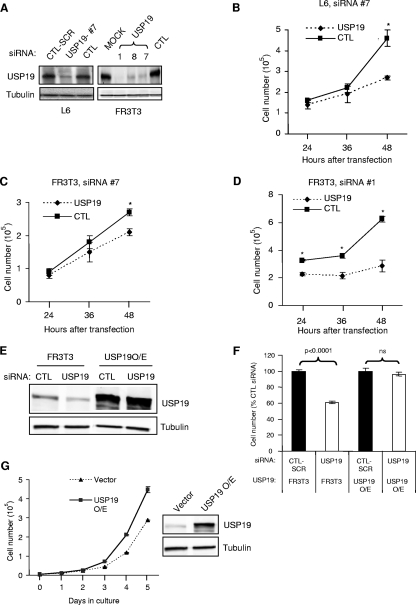FIG. 1.
Depletion of USP19 leads to reduced cell proliferation. (A) Effectiveness of USP19 siRNA oligonucleotides in depleting the enzyme. L6 myoblasts and FR3T3 fibroblasts were transfected with USP19 or scrambled (CTL-SCR) or nonspecific control siRNA oligonucleotides (CTL) or transfected without siRNA oligonucleotides (MOCK). Forty-eight hours after transfection, cells were harvested and the lysate subjected to immunoblot analysis with antibody against either USP19 or γ-tubulin. #7, 1, 8, and 7, USP19 siRNA oligonucleotides. (B to D) Cells depleted of USP19 show reduced proliferation. L6 myoblasts (B) or FR3T3 fibroblasts (C, D) were transfected with USP19 siRNA oligonucleotide no. 7 (#7) (B and C) or no. 1 (#1) (D) or nonspecific or scrambled control (CTL) siRNA oligonucleotides. Cell numbers were determined at the indicated times after transfection. Shown are means ± standard deviations of the results. *, significantly different from results for control oligonucleotide transfection (P < 0.001). (E) Normal FR3T3 cells or those stably overexpressing (O/E) USP19 bearing mutations that do not change the coding sequence but render the mRNA resistant to siRNA-mediated degradation were transfected with USP19 siRNA or scrambled siRNA (CTL). After 48 h, cells were harvested and lysates prepared and analyzed by immunoblotting. (F) Normal proliferation in cells expressing USP19 resistant to siRNA. Cells were treated as described for panel E and counted at 48 h after transfection with the indicated siRNA oligonucleotides. Shown are means ± standard errors of the results. (G) Expression of exogenous USP19 increases the rate of cell proliferation. FR3T3 cells stably overexpressing Flag-tagged USP19 were cultured for the indicated number of days. Vector-transfected FR3T3 cells were used as control. Shown are means ± standard errors of the results.

